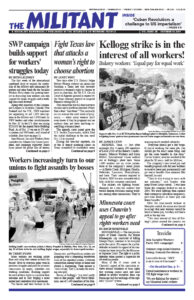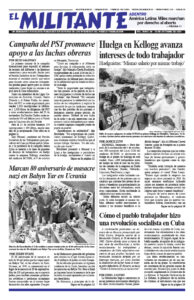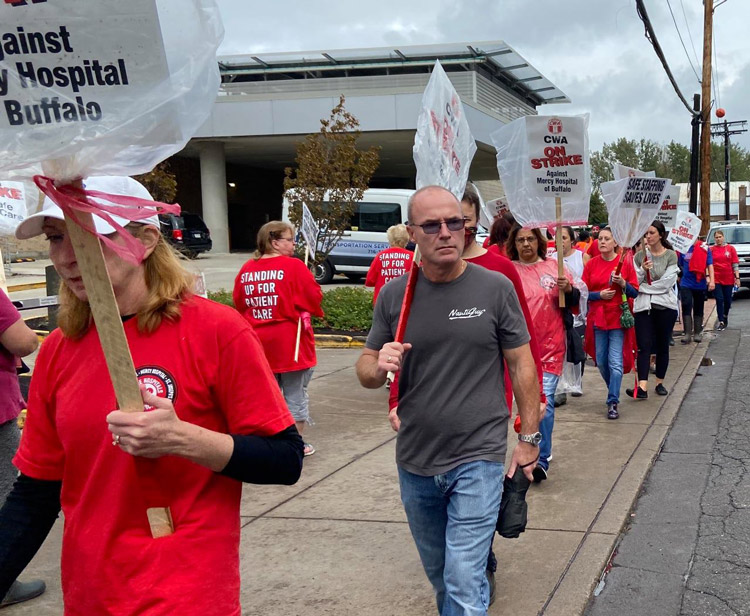More workers are walking picket lines and using their unions to resist the bosses’ drive to overturn gains won in previous struggles and push for yet more concessions on wages, schedules and working conditions. Building support for each of these fights is crucial to their outcome and to start forging a more united and combative labor movement.
The bosses and their backers in the Democratic and Republican parties are grappling with a deepening worldwide crisis of the capitalist system. Cutthroat competition among bosses at home and abroad is sharpening. Their answer is “cost cutting,” that is, to make the working class pay.
Bosses at Kellogg’s “just don’t really treat us like people,” said Trevor Bidelman, one of 1,400 members of the Bakery, Confectionery, Tobacco Workers and Grain Millers union currently on strike at the company’s four cereal plants. Millions face similar assaults on dignity on the job. More workers are resisting union busting, draconian schedules and shifts, two- and three-tier contracts with worse wages and benefits for new hires, attacks on wages and overtime pay, and other concessions aimed at dividing workers to better defend the bosses’ profits.
A four-decade decline in the number of workers involved in major strikes was reversed beginning in 2019, reports the Bureau of Labor Statistics, which records strikes of over 1,000 workers. Despite a sharp drop in strikes at the beginning of the pandemic, workers in basic industry are now standing up to employers’ attacks in larger numbers, and turning to our main defensive organizations — our unions — to do so.
Alongside the fight by BCTGM members at Kellogg’s, there are strikes and fights against lockouts at factories, mines, oil refineries and other workplaces. During recent contract negotiations, 60,000 members of the International Alliance of Theatrical Stage Employees voted by 98% to authorize a nationwide strike, for the first time in the union’s history. The bosses’ media outlets are taking note. “U.S. Workers Are Realizing It’s the Perfect Time to Go on Strike,” a headline in Time magazine said Oct. 8.
Crisis of jobs, wages, rising prices
The government says unemployment dropped last month from 5.2% to 4.8%. But this wasn’t because the unemployed found jobs. More workers “dropped out” of the labor force, concluding it’s not worth taking jobs the bosses are offering at wages so low it’s hard to survive and in wretched conditions.
The media is full of bosses’ complaints that they can’t hire enough workers, even though there are 5 million less workers with jobs than before the pandemic. They say this is causing wages to rise. But real wages, when you take into account rising prices, have declined since May 2020. They dropped for every one of the first five months of Joseph Biden’s presidency.
The personal consumption expenditure index, which doesn’t include prices for food and rent, rose 3.6% last month compared to a year ago, to the highest level since 1991. Basic necessities that make up a big proportion of workers’ expenditures are rising faster. Meat, poultry, fish and eggs are up 5.9% over last year, and 15.7% since August 2019.
Fuel and electricity prices are soaring globally, as coal production, which generates 40% of the world’s electricity, remains 5% below pre-pandemic levels, and supply lines are in crisis. Governments allied in OPEC refuse to increase production of crude oil, keeping its price at the highest level in seven years.
Many in the meritocratic middle-class in the U.S. are blind to what workers and farmers face and see inflation as positive. “To see price pressure picking up,” Blerina Uruci, a senior economist at Barclays, claims “it’s progress.”
Increasing fear of working class
Those in the social layer Uruci is part of honeycomb government agencies, “nonprofit” organizations and universities. They are convinced their schooling and “brightness” equip them to regulate the lives of working people, who can’t be trusted to know what’s in our own best interest. They churn out “theories” that are gobbled up in the liberal press to justify why workers are “deplorables” and must be considered dangerous.
Their hatred of working people is captured in the Oct. 7 article “What Killed the Blue-Collar Struggle for Social Justice” by New York Times editorial board member Farah Stockman. She fears the “American experiment is unraveling” because of the attitudes of workers, who might elect Donald Trump again in 2024. She says workers she met who lost their jobs at a ball-bearing factory in Indianapolis, and ended up in worse-paying jobs, are unalterably anti-immigrant. They’re a “toxic mix of hope, rage and despair.”
These meritocratic layers — and the ruling class they defend — increasingly fear the working class.
But as today’s strikes show, far from having no capacity to come together to defend ourselves workers are discovering our self-worth as we fight side by side. As we build unions we find ways to overcome the divisions bosses continually use to try to weaken our class.


